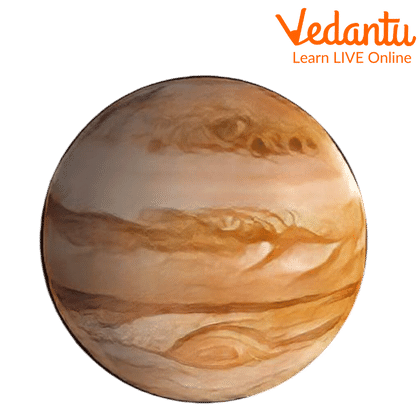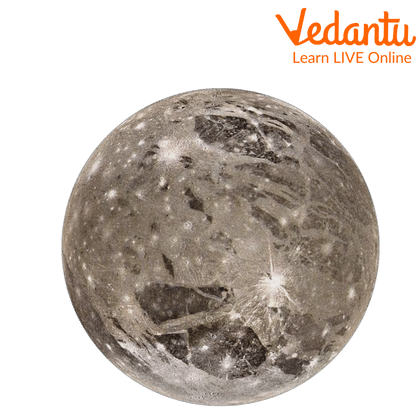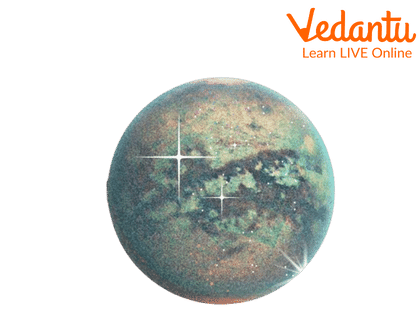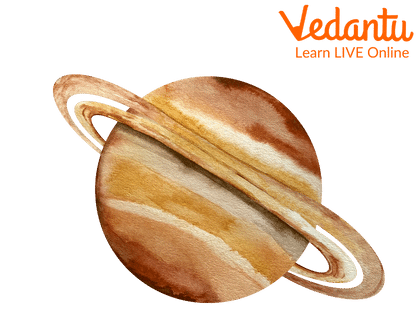




Facts About Titan (Saturn's Moon)
There are more than 200 moons in our solar system, of which the largest moon is Ganymede (Jupiter's Moon), and it revolves around the planet Jupiter. After this comes a moon of the planet Saturn, whose name is Titan. It is the second largest moon in the solar system and it is also very special for us humans because it is the only moon that has a very dense and exactly like a planet's atmosphere.

Jupiter.

Ganymede Moon
Titan’s Atmosphere
Titan's atmosphere, composed of 95% nitrogen gas and 5% methane gas, is the strongest in the solar system; in addition to these two gases, it also contains the organic molecules carbon and hydrogen necessary for life.

The Titan.
Titan's Size and Saturn's Orbit
Talking about the size, the diameter of Titan is about 5150 km, almost equal to Mars. Its surface temperature is -179 °C, which makes water as strong as stone and liquid like methane. Its surface pressure is slightly higher than the surface pressure of our Earth.
If we talk about its orbital period, then Titan completes one revolution of Saturn in equal time to 16 days of Earth. Due to being closer than its planet, it looked like our moon, which means that the surface of one side of Titan always remains in front of Saturn and the other away from it.

The Saturn.
Titan Craters
Scientists previously believed that the hydrocarbon (a compound consisting entirely of hydrogen and carbon). Lakes present on Titan were formed due to the melting of solid things present there. But, according to new research published in Nature GeoScience, the craters present on Titan are the result of explosions of nitrogen gas.
In fact, due to the increase in the surface temperature of Titan, nitrogen gas turns into steam and comes out with a bang, which creates large craters. Later these pits are filled due to rain of methane, ethane and hydrocarbons, and this is how hydrocarbon lakes are formed on Titan.
Solved Questions
1. Why is life expected to be found on Titan?
Ans: We only know about the earth with the belief that there is life here, so where else there can be life, we do not know. However, we do know that life is made up of complex organic molecules (a complex molecule that contains the element carbon bonded with other elements). This is something that we find on Titan in substantial quantities, in the form of the complex chemical 'Tholin' that we don't know much about. Tholin may be more like tar to life than we know it, but it may be an organic molecule necessary for the beginning of life.
2. How different is it to design missions and equipment for Titan or Saturn than for Mars or the Moon?
Ans: Titan is very different from the Moon or Mars because its atmosphere is much thicker, and denser than Earth's. It is also extremely cold, with an average temperature of -180 °C. This means that everything we design must be able to operate far below the temperature of Earth or Mars (such as the midnight temperature on the Moon).
Practice Questions
Write True or False.
There are only 200 Moons in our Solar System.
The name of the largest Moon is Ganymede.
In 2003, the Cassini spacecraft was sent to collect more information about Titan.
Titan is many times better than Mars in terms of settling down.
Summary
Titan is the second largest moon of the planet Saturn in the Solar System. Titan's atmosphere is composed of 95% nitrogen gas and 5% methane gas. It also contains the organic molecules carbon and hydrogen necessary for life. The diameter of Titan is about 5150 km, which is almost exactly equal to Mars. The craters present on Titan are the result of explosions of nitrogen gas.
FAQs on The Titan (Moon) Facts
1. Is there any sea found on Titan?
Scientists have discovered a sea on Titan and they believe that it can be more than 1000 feet deep. The name of this sea is Kraken Mare. This ocean is made up entirely of liquid methane and ethane and is located at the north pole of Titan.
Kraken Mare Sea.
2. What could be the obstacles in getting concrete results in this direction?
Bringing samples from Titan is a very difficult project. The biggest problem is that Titan is very far away. 1.5 billion kilometres from the Sun and 6 times farther than Mars. This makes it very difficult to get to and operate on Titan, and sending samples back to Earth from Titan would require a lot of fuel. That's why we want to build our fuel on Titan, rather than take it from Earth.
3. Do any features of Titan, chemical or physical, resemble ancient or present-day Earth?
Titan is the only moon in the Solar System to have a thick atmosphere and the only body (planet or moon) that has visible sources of liquid on its surface. Titan has liquid hydrocarbons – methane and ethane – but it still has lakes, clouds, and weather like Earth, even if it rains methane during the season.









